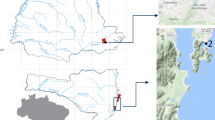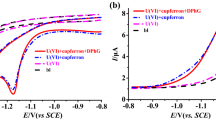Abstract
This study investigated whether differential pulse anodic stripping voltammetry (DPASV) with a solid gold electrode could be used for arsenic speciation of mine-influenced water. The DPASV parameters were optimized using a 100-µg L−1 As(III) standard solution. The procedure for chemical reduction of As(V) to As(III) using thiosulfate prior to DPASV measurements was also optimized. Two samples of mine-influenced waters from the Witwatersrand mining area, an acid mine drainage (AMD) and a more dilute Fleurhof dam water sample, were used to assess the method viability. Interference from elements in the AMD proved insurmountable using this technique alone; the method was also unable to detect arsenic in the dam water sample. However, spiked dam water samples gave percent recoveries of 81.6% and 123% for As(III) and As(V), respectively, showing that arsenic species in mine-influenced water can be effectively determined if the method is reoptimized for lower arsenic concentrations.
Zusammenfassung
Diese Studie untersuchte, ob anodische differentielle Pulsvoltametrie ((DPASV) mit einer festen Goldelektrode geeignet ist, die Speziierung von Arsen in belastetem Bergbauwasser zu bestimmen. DPASV Parameter wurden mittels einer 100-µg L-1 As(III) Standardlösung optimiert. Auch die Prozedur der chemischen Reduktion von As(V) zu As(III) mittels Thiosulfat vor der DPASV-Messung wurde optimiert. Zwei Proben von bergbaubeeinflusstem Wasser aus dem BergbaudistriktWitwatersrand, ein saures Bergbausickerwasser (AMD) und eine Probe von gering belastetem Wasser aus dem Fleurhof-Stausee wurden zur Untersuchung der Eignung der Methode untersucht. Interferenzen mit anderen Elementen in der AMD konnten mit dieser Technik nicht überwunden werden; die Methode war nicht imstande, Arsen in der Stauseewasserprobe zu messen. ‘Spiking’ der Stauseewasserprobe jedoch ergab ein Ausbringen von 81.6% für As(III) und 123% für As(V). Somit ist nachgewiesen, daß Arsenspezies in bergbaubeeinflusstem Wasser effektiv gemessen werden können, soferne die Methode für niedrige Arsengehalte optimiert wird.
抽象
研究了固体金棒电极的差分脉冲阳极溶出伏安法(DPASV)是否可用于受采矿影响水的砷形态分析。以100-μg L-1 AS(III)标准溶液优化DPASV参数。在DPASV测试前,用硫代硫酸盐优化砷(V)至砷(III)的还原过程。利用威特沃特斯兰(Witwatersrand)矿区的一个酸性矿山废水样(AMD)和一个稀释的Fleurhof大坝水样试验DPASV方法的可行性。试验证明,如果仅用DPASV方法,无法克服矿井废水(AMD)中元素干扰问题,也未能检测出大坝水样中的砷。然而,加入标液处理后的大坝水样的砷(III)和砷(V)回收率分别为81.6%和123%。如果将DPASV方法针对低砷浓度水样重新优化,则DPASV可有效检测受矿井影响水的砷形态。
Resumen
Este estudio investigó si la voltametría de redisolución anódica de pulso diferencial (DPASV) con un electrodo de oro sólido podría usarse para la especiación de arsénico del agua influenciada por la actividad minera. Los parámetros DPASV se optimizaron usando una solución estándar de 100 µg L-1 As(III). También fue optimizado el procedimiento para la reducción química de As(V) a As(III) usando tiosulfato antes de las mediciones de DPASV. Se utilizaron dos muestras de aguas del área minera de Witwatersrand, un drenaje ácido de la mina (AMD) y una muestra más diluida con agua de la presa Fleurhof, para evaluar la viabilidad del método. La interferencia de los elementos en la AMD resultó excesiva usando sólo esta técnica; el método tampoco pudo detectar arsénico en la muestra de agua de la presa. Sin embargo, las muestras diluidas dieron porcentajes de recuperación de 81,6% y 123% para As(III) y As(V), respectivamente, demostrando que las especies de arsénico en el agua impactadas por la minería podrían determinarse efectivamente si el método se re-optimiza para concentraciones menores de arsénico.








Similar content being viewed by others
References
Akter KF, Owens G, Davey DE, Naidu R (2005) Arsenic speciation and toxicity in biological systems. Rev Environ Contam T 184:97–149
Alves GM, Magalhães JM, Salaün P, Van den Berg CM, Soares H (2011) Simultaneous electrochemical determination of arsenic, copper, lead and mercury in unpolluted fresh waters using a vibrating gold microwire electrode. Anal Chim Acta 703(1):1–7
B’Hymer C, Caruso JA (2004) Arsenic and its speciation analysis using high-performance liquid chromatography and inductively coupled plasma mass spectrometry. J Chromatogr A 1045(1–2):1–13. https://doi.org/10.1016/j.chroma.2004.06.016
Berg M, Stengel C, Trang PTK, Viet PH, Sampson ML, Leng M, Samreth S, Fredericks D (2007) Magnitude of arsenic pollution in the Mekong and Red River deltas—Cambodia and Vietnam. Sci Total Environ 372(2–3):413–425
Breuer PL, Jeffrey MI (2003) The reduction of copper (II) and the oxidation of thiosulfate and oxysulfur anions in gold leaching solutions. Hydrometallurgy 70(1–3):163–173
Bu L, Gu T, Ma Y, Chen C, Tan Y, Xie Q, Yao S (2015) Enhanced cathodic preconcentration of As (0) at Au and Pt electrodes for anodic stripping voltammetry analysis of As (III) and As (V). J Phys Chem C 119(21):11400–11409
Caruso JA, Montes-Bayon M (2003) Elemental speciation studies—new directions for trace metal analysis. Ecotox Environ Saf 56(1):148–163. https://doi.org/10.1016/S0147-6513(03)00058-7
Choi JY, Khan N, Nho EY, Choi H, Park KS, Cho MJ, Youn HJ, Kim KS (2016) Speciation of arsenic in rice by high-performance liquid chromatography–inductively coupled plasma mass spectrometry. Anal Lett 49(12):1926–1937
Dai X, Nekrassova O, Hyde ME, Compton RG (2004) Anodic stripping voltammetry of arsenic (III) using gold nanoparticle-modified electrodes. Anal Chem 76(19):5924–5929
Duruibe JO, Egwurugwu J (2007) Heavy metal pollution and human biotoxic effects. Int J Phys Sci 2(5):112–118
Garelick H, Jones H, Dybowska A, Valsami-Jones E (2009) Arsenic pollution sources. Rev Environ Contam T 197:17–60
Ghosal U, Sikdar PK, McArthur JM (2015) Palaeosol control of arsenic pollution: the Bengal Basin in West Bengal, India. Ground Water 53(4):588–599
Greschonig H, Kurt J (1992) Electrochemical methods for the compounds. Appl Organomet Chem 6(7):565–577
Hughes MF (2002) Arsenic toxicity and potential mechanisms of action. Toxicol Lett 133(1):1–16
Li D, Li J, Jia X, Han Y, Wang E (2012) Electrochemical determination of arsenic (III) on mercaptoethylamine modified Au electrode in neutral media. Anal Chim Acta 733:23–27
Ma L, Wang L, Jia Y, Yang Z (2016) Arsenic speciation in locally grown rice grains from Hunan Province, China: spatial distribution and potential health risk. Sci Total Environ 557:438–444
Mays DE, Hussam A (2009) Voltammetric methods for determination and speciation of inorganic arsenic in the environment—a review. Anal Chim Acta 646(1–2):6–16. https://doi.org/10.1016/j.aca.2009.05.006
Melashvili M, Dreisinger D, Choi Y (2016) Cyclic voltammetry responses of gold electrodes in thiosulphate electrolyte. Miner Eng 92:134–140
Metrohm (2010) Determination of arsenic by anodic stripping voltammetry at the rotating gold electrode (Application Bulletin 226/2)
Michalke B (2002) The coupling of LC to ICP-MS in element speciation—part II: recent trends in application. Trac-Trend Anal Chem 21(3):154–165
Naicker K, Cukrowska E, McCarthy TS (2003) Acid mine drainage arising from gold mining activity in Johannesburg, South Africa and environs. Environ Pollut 122(1):29–40. https://doi.org/10.1016/S0269-7491(02)00281-6
Nordstrom DK, Archer DG (2003) Arsenic thermodynamic data and environmental geochemistry. Arsenic in ground water. Springer, Boston, pp 1–25
Paul SC, Rahman MA, Alam AS (2007) Voltammetric study of arsenic (III) and arsenic (V) in ground water of Hajigonj and Kalkini in Bangladesh. Pak J Anal Environ Chem 8(1):7
Profumo A, Merli D, Pesavento M (2005) Voltammetric determination of inorganic As(III) and total inorganic As in natural waters. Anal Chim Acta 539(1–2):245–250
Raj KR, Saxena S, Kardam A, Satsangi SP, Srivastava S (2014) Voltammetric speciation of arsenic species in plant biomaterial: bioremediation. Clean Technol Environ 16(2):377–384
Rosen AL, Hieftje GM (2004) Inductively coupled plasma mass spectrometry and electrospray mass spectrometry for speciation analysis: applications and instrumentation. Spectrochim Acta B 59(2):135–146. https://doi.org/10.1016/j.sab.2003.09.004
Sharma VK, Sohn M (2009) Aquatic arsenic: toxicity, speciation, transformations, and remediation. Environ Int 35(4):743–759
Smedley PL, Kinniburgh DG (2001) A review of the source, behaviour and distribution of arsenic in natural waters. Appl Geochem 17(5):517–568. https://doi.org/10.1016/S0883-2927(02)00018-5
Sun YC, Mierzwa J, Yang MH (1997) New method of gold-film electrode preparation for anodic stripping voltammetric determination of arsenic (III and V) in seawater. Talanta 44:1379–1387. https://doi.org/10.1016/S0039-9140(96)02197-2
Tutu H, Cukrowska EM, Dohnal V, Havel J (2005) Application of artificial neural networks for classification of uranium distribution in the central Rand goldfield, South Africa. Environ Model Assess 10(2):143–152
Ungureanu G, Santos S, Boaventura R, Botelho C (2015) Arsenic and antimony in water and wastewater: overview of removal techniques with special reference to latest advances in adsorption. J Environ Manage 151:326–342
Van Hulle M, Zhang C, Zhang X, Cornelis R (2002) Arsenic speciation in Chinese seaweeds using HPLC-ICP-MS and HPLC-ES-MS. Analyst 127(5):634–640
Wang S, Mulligan CN (2006) Occurrence of arsenic contamination in Canada: sources, behavior and distribution. Sci Total Environ 366(2–3):701–721. https://doi.org/10.1016/j.scitotenv.2005.09.005
WHO (2011) Guidelines for drinking-water quality. 4th edn., Gutenberg, Malta. https://www.who.int/water_sanitation_health/publications/2011/dwq_guidelines/en/ Accessed 05 May 2019
Xiao L, Wildgoose GG, Compton RG (2008) Sensitive electrochemical detection of arsenic (III) using gold nanoparticle modified carbon nanotubes via anodic stripping voltammetry. Anal Chim Acta 620(1–2):44–49. https://doi.org/10.1016/j.aca.2008.05.015
Yamada D, Ivandini TA, Komatsu M, Fujishima A, Einaga Y (2008) Anodic stripping voltammetry of inorganic species of As3+ and As5+ at gold-modified boron doped diamond electrodes. J Electroanal Chem 615(2):145–153
Yang JQ, Chai LY, Li QZ, Shu YD (2017) Redox behavior and chemical species of arsenic in acidic aqueous system. T Nonferr Metal Soc 27(9):2063–2072
Zhang L, Qin X, Tang J, Liu W, Yang H (2017) Review of arsenic geochemical characteristics and its significance on arsenic pollution studies in karst groundwater, southwest China. Appl Geochem 77:80–88
Zhou C, Yang M, Li SS, Jiang TJ, Liu JH, Huang XJ, Chen X (2017) Electrochemically etched gold wire microelectrode for the determination of inorganic arsenic. Electrochim Acta 231:238–246
Zlatev R, Stoytcheva M, Valdez B (2010) As(III) determination in the presence of Pb(II) by differential alternative pulses voltammetry. Electroanalysis 22(15):1671–1674. https://doi.org/10.1002/elan.201000090
Acknowledgements
This work was funded by the National Research Foundation (NRF) of South Africa, Grant SFH170606237620.
Author information
Authors and Affiliations
Corresponding authors
Electronic supplementary material
Below is the link to the electronic supplementary material.
Rights and permissions
About this article
Cite this article
Ramaqele, M., Billing, C., Cukrowska, E.M. et al. In Search of a Speciation Method for Arsenic in Mine-Influenced Waters: Is Differential Pulse Anodic Stripping Voltammetry the Answer?. Mine Water Environ 38, 837–846 (2019). https://doi.org/10.1007/s10230-019-00630-4
Received:
Accepted:
Published:
Issue Date:
DOI: https://doi.org/10.1007/s10230-019-00630-4




